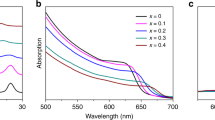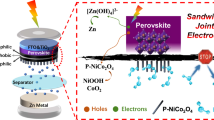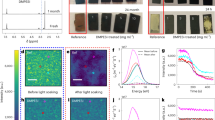Abstract
THERE is much interest in photo-electrochemical cells which use a semiconductor–electrolyte junction to transduce light into electrical and chemical energy1. The semiconductors investigated to date fall into two main groups, the first of which contains photostable material but which shows response in the UV rather than the visible region of the spectrum, for example, n-titanium dioxide2, n-strontium titanate3, n-potassium tantalate4, n-tin oxide5 and n-barium titanate6. The second group comprises compounds which respond to the visible region of the spectrum but are photochemically unstable such as n-gallium phosphide7, n-indium phosphide8, n-cadmium sulphide9, and n-cadmium selenide10. Attempts have been made to extend the spectral response of the materials belonging to the first group, by doping11 and chemically affixing dyes to the surface of the semiconductor12. Some success has been attained in stabilising some of the members of the second group; for example, cadmium sulphide and selenide are stable in poly-chalcogenide solutions13. If cells containing a semiconductor–electrolyte junction are to be of any practical use in the harnessing of solar energy then the following criteria for the semiconductor should be met: (1) they should absorb visible radiation; and (2) be photostable and capable of use in powder form. Clearly, if the conduction and valence bands of the semiconductor have energies that facilitate proton reduction and oxidation of hydroxyl ions respectively this would be an added bonus as the cells could be used to either photo-assist or photo-electrolyse the water14. We report here on mercury(II) sulphide (cinnabar) band gap = 2.1 eV15 which fulfils most of the above criteria16.
This is a preview of subscription content, access via your institution
Access options
Subscribe to this journal
Receive 51 print issues and online access
$199.00 per year
only $3.90 per issue
Buy this article
- Purchase on Springer Link
- Instant access to full article PDF
Prices may be subject to local taxes which are calculated during checkout
Similar content being viewed by others

References
Gerischer, H. J. electroanalyt. Chem. Interfacial Electrochem. 58, 263–274 (1975).
Mavroides, J. G., Tchernev, D. I., Kafalas, J. A. & Kolesar, D. F. Mater. Res. Bull. 10, 1023–1030 (1975).
Watanabe, T., Fujishima, A. & Honda, K. Bull. chem. Soc. Jap. 49, 355–358 (1976).
Ellis, A. B., Kaiser, S. W. & Wrighton, M. S. J. phys. Chem. 80, 1325–1328 (1976).
Wrighton, M. S., Morse, D. L., Ellis, A. B., Ginley, D. S. & Abrahamson, H. B. J. Am. chem. Soc. 98, 44–48 (1976).
Nasby, R. D. & Quinn, R. K. Mater. Res. Bull. 11, 985–992 (1975).
Nozik, A. J. Appl. Phys. Lett. 29, 150–153 (1976).
Vervaet, A. A. K., Gomes, W. P. & Cardon, F. J. electroanalyt. Chem. 91, 133–136 (1978).
Gerischer, H. & Gobrecht, J. Ber. Bunsenges Phys. Chem. 80, 327–330 (1976).
Ellis, A. B., Kaiser, S. W. & Wrighton, M. S. J. Am. chem. Soc. 98, 1635–1637 (1976).
Ghosh, A. K. & Maruska, H. P. J. electrochem. Soc. 124, 1516–1522 (1977).
Kim, H. & Laitinen, H. J. electrochem. Soc. 122, 53–58 (1975).
Ellis, A. B., Kaiser, S. W. & Wrighton, M. S. J. Am. chem. Soc. 98, 6855–6866 (1975).
Bolts, J. M. & Wrighton, M. S. J. phys. Chem. 80, 2641–2645 (1976).
Strehlow, W. H. & Cook, E. L. J. phys. Chem. Ref. Data 2, 163–193 (1973).
Br. Patent Appl. No. 16766/78 (27 April, 1978) and 47745/78 (8 December 1978).
Author information
Authors and Affiliations
Rights and permissions
About this article
Cite this article
DAVIDSON, R., WILLSHER, C. Mercury(II) sulphide: a photo-stable semiconductor. Nature 278, 238–239 (1979). https://doi.org/10.1038/278238a0
Received:
Accepted:
Issue Date:
DOI: https://doi.org/10.1038/278238a0
This article is cited by
-
Direct evidence for metallic mercury causing photo-induced darkening of red cinnabar tempera paints
Communications Chemistry (2021)
-
The electrochemical behaviour of light-sensitive electrodes formed by coating a platinum mesh with a powdered semiconductor
Journal of Applied Electrochemistry (1982)
Comments
By submitting a comment you agree to abide by our Terms and Community Guidelines. If you find something abusive or that does not comply with our terms or guidelines please flag it as inappropriate.


